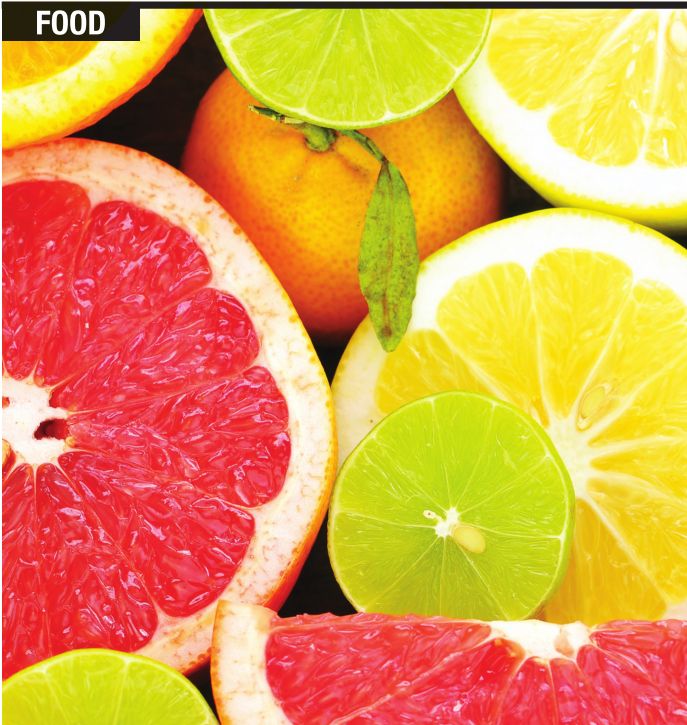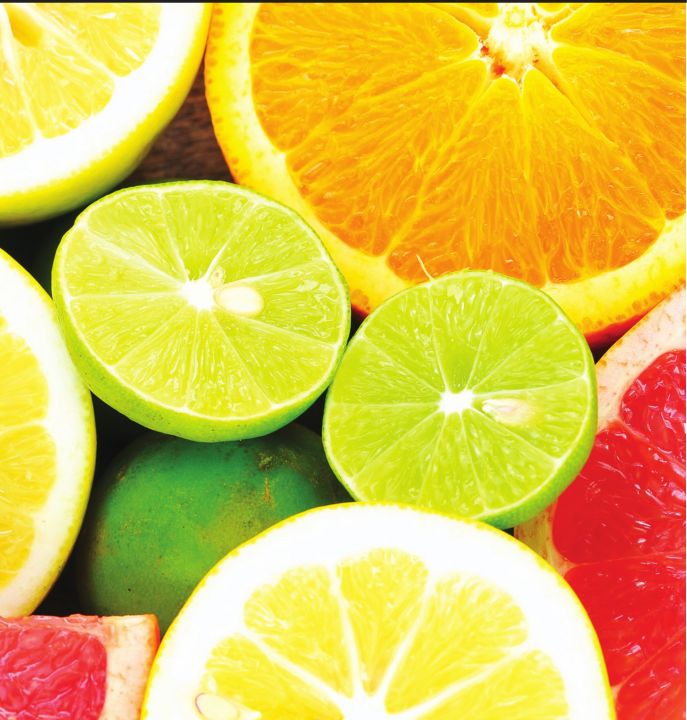

From Cara Caras to clementines
After weeks of rich wintery fare, nature has a way of offering her own elixir. Citrus fruits are in peak season now through early spring, arriving just in time to pull us out of our butter-laden holiday haze. Bright, refreshing and packed with nutrients, these sunny fruits liven up savory and sweet dishes alike.
The selection in grocery stores today is more varied than ever. Home cooks are blessed with easy access to exotic blood oranges, tart kumquats and floralscented Meyer lemons, just to name a few.
Generations of crossbreeding and natural hybridization have resulted in this delicious variety of citrus fruits, and they are all descended from three main citrus species: citron, pomelo and mandarin.
Citron can be the most difficult to find fresh and is used primarily for its zest and to make a candied peel. Buddha’s Hand, which is indeed shaped like a hand, is an interesting variety that is sometimes available in local groceries. Clementines, tangerines, tangelos and satsumas are some of the many varieties derived from mandarins. Generally they are sweeter and easier to peel. Pomelos are the largest citrus fruits, and look like a big fleshy grapefruit with yellow-green skin.
Oranges as we know them are a cross between pomelo and mandarin. They are further categorized into three groups: navels, blood oranges and Valencia. Navel oranges are the most common and include varieties such as the cranberry-hued Cara Cara orange, which gets it unique color from lycopene, a carotenoid pigment that is useful in preventing cardiovascular disease and certain cancers. Blood oranges get their deep red color from another type of plant pigments known as anthocyanins, the same powerful compounds found in dark red and blue berries. Valencia oranges come into season mid-spring and are available through summer. Harder to peel and slightly more tart, these are ideal oranges for juicing and zesting.
Grapefruits, a cross between a pomelo and an orange, are either pink or white fleshed. The ruby red variety tends to be the sweetest – look for firm fruits with a rosy red hue. A combination of different orange and grapefruit varieties
makes a gorgeous fruit salad that keeps well in the fridge for a week. I
like to prepare a large container on Sunday to enjoy all week long.
This mixed citrus salad brightens up a sad desk lunch and even helps
speed along weeknight dinners. Top fresh spinach with cut-up citrus
fruits, along with sliced red onion, shaved fennel, pomegranate seeds,
candied walnuts and balsamic vinaigrette. This salad is an excellent
accompaniment to simple roasted fish or chicken.
Kumquats
are the only citrus variety that should be eaten whole, skin and all.
These small, egg-shaped fruits are native to South Asia and were
imported to Europe in the 1840s. The name, translated from Cantonese,
literally means “golden tangerine.” The skin of these little fruits is
sweet, while the flesh and juice inside are sour, resulting in a
delicious interplay of flavors. Kumquats are often candied and can also
be sliced and added to salads or used to make citrus chutney or
marmalade.
When
shopping for citrus fruit, look for firm fruits that are heavy for their
size. Refrigerating will extend the shelf life of citrus fruit, though
if you plan to juice the fruit leave it out on the countertop overnight.
Room temperature fruit will yield more juice. Airflow is important, so
be sure to store your citrus in mesh or cloth bags. The zest and the
juice both freeze well, a nice option if you find yourself blessed with
an abundance of fruit.
My
grandmother is a lemon lover and has a January birthday. When I asked
her what she wanted for her birthday dessert this year she pulled out an
old typewritten recipe card for Lemon Pudding. This baked lemon dessert
was one of the earliest dishes she remembers learning how to make – “I
was always tempted to eat half the batter before it went into the oven,”
she said, “It was so, so good.”
Grandma’s Lemon Pudding
• 2 eggs
• 2 tablespoons butter
• ¾ cup sugar
• Juice and rind of one lemon
• ¼ cup flour
• 1 cup milk
Preheat
oven to 350 degrees and butter an 8-inch square ceramic baking dish.
Separate the eggs, being careful not to let the egg yolks contaminate
the whites. Beat the egg whites to stiff peaks and set aside. Cream the
butter and sugar. Add the well-beaten yolks, lemon juice and zest and
flour. Mix thoroughly, and then mix in the milk. Fold in the stiffly
beaten egg whites and pour the batter into the prepared baking dish. Set
the dish in a 9x13-inch pan and pour in boiling water to reach halfway
up the side of the 8-inch pan. Bake 45 minutes until light golden brown.
Cake will be set on top and will create its own sauce in the bottom of
the pan.
Contact Ashley Meyer at [email protected].